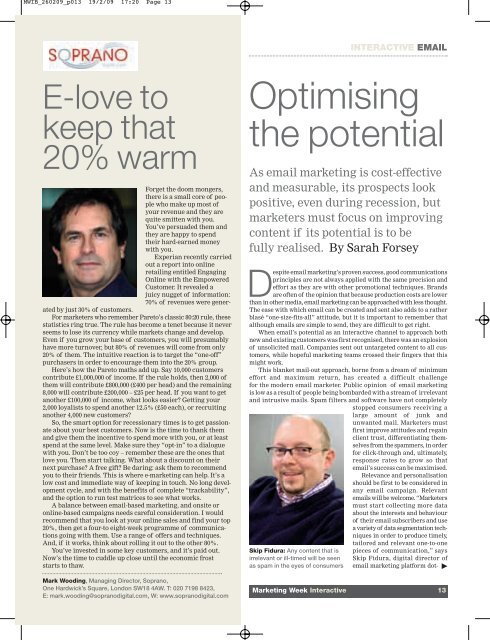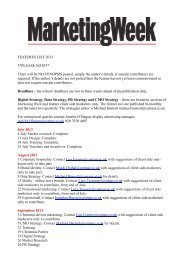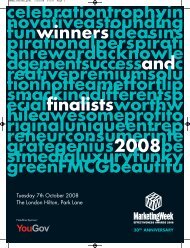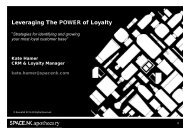Interactive Seven 2009 Supplement - Marketing Week
Interactive Seven 2009 Supplement - Marketing Week
Interactive Seven 2009 Supplement - Marketing Week
You also want an ePaper? Increase the reach of your titles
YUMPU automatically turns print PDFs into web optimized ePapers that Google loves.
MWIB_260209_p013 19/2/09 17:20 Page 13<br />
INTERACTIVE EMAIL<br />
E-love to<br />
keep that<br />
20% warm<br />
Forget the doom mongers,<br />
there is a small core of people<br />
who make up most of<br />
your revenue and they are<br />
quite smitten with you.<br />
You’ve persuaded them and<br />
they are happy to spend<br />
their hard-earned money<br />
with you.<br />
Experian recently carried<br />
out a report into online<br />
retailing entitled Engaging<br />
Online with the Empowered<br />
Customer. It revealed a<br />
juicy nugget of information:<br />
70% of revenues were generated<br />
by just 30% of customers.<br />
For marketers who remember Pareto’s classic 80:20 rule, these<br />
statistics ring true. The rule has become a tenet because it never<br />
seems to lose its currency while markets change and develop.<br />
Even if you grow your base of customers, you will presumably<br />
have more turnover, but 80% of revenues will come from only<br />
20% of them. The intuitive reaction is to target the “one-off”<br />
purchasers in order to encourage them into the 20% group.<br />
Here’s how the Pareto maths add up. Say 10,000 customers<br />
contribute £1,000,000 of income. If the rule holds, then 2,000 of<br />
them will contribute £800,000 (£400 per head) and the remaining<br />
8,000 will contribute £200,000 – £25 per head. If you want to get<br />
another £100,000 of income, what looks easier? Getting your<br />
2,000 loyalists to spend another 12.5% (£50 each), or recruiting<br />
another 4,000 new customers?<br />
So, the smart option for recessionary times is to get passionate<br />
about your best customers. Now is the time to thank them<br />
and give them the incentive to spend more with you, or at least<br />
spend at the same level. Make sure they “opt-in” to a dialogue<br />
with you. Don’t be too coy – remember these are the ones that<br />
love you. Then start talking. What about a discount on their<br />
next purchase? A free gift? Be daring: ask them to recommend<br />
you to their friends. This is where e-marketing can help. It’s a<br />
low cost and immediate way of keeping in touch. No long development<br />
cycle, and with the benefits of complete “trackability”,<br />
and the option to run test matrices to see what works.<br />
A balance between email-based marketing, and onsite or<br />
online-based campaigns needs careful consideration. I would<br />
recommend that you look at your online sales and find your top<br />
20%, then get a four-to eight-week programme of communications<br />
going with them. Use a range of offers and techniques.<br />
And, if it works, think about rolling it out to the other 80%.<br />
You’ve invested in some key customers, and it’s paid out.<br />
Now’s the time to cuddle up close until the economic frost<br />
starts to thaw.<br />
Mark Wooding, Managing Director, Soprano,<br />
One Hardwick’s Square, London SW18 4AW. T: 020 7198 8423,<br />
E: mark.wooding@sopranodigital.com, W: www.sopranodigital.com<br />
Optimising<br />
the potential<br />
As email marketing is cost-effective<br />
and measurable, its prospects look<br />
positive, even during recession, but<br />
marketers must focus on improving<br />
content if its potential is to be<br />
fully realised. By Sarah Forsey<br />
Despite email marketing’s proven success, good communications<br />
principles are not always applied with the same precision and<br />
effort as they are with other promotional techniques. Brands<br />
are often of the opinion that because production costs are lower<br />
than in other media, email marketing can be approached with less thought.<br />
The ease with which email can be created and sent also adds to a rather<br />
blasé “one-size-fits-all” attitude, but it is important to remember that<br />
although emails are simple to send, they are difficult to get right.<br />
When email’s potential as an interactive channel to approach both<br />
new and existing customers was first recognised, there was an explosion<br />
of unsolicited mail. Companies sent out untargeted content to all customers,<br />
while hopeful marketing teams crossed their fingers that this<br />
might work.<br />
This blanket mail-out approach, borne from a dream of minimum<br />
effort and maximum return, has created a difficult challenge<br />
for the modern email marketer. Public opinion of email marketing<br />
is low as a result of people being bombarded with a stream of irrelevant<br />
and intrusive mails. Spam filters and software have not completely<br />
stopped consumers receiving a<br />
large amount of junk and<br />
unwanted mail. Marketers must<br />
first improve attitudes and regain<br />
client trust, differentiating themselves<br />
from the spammers, in order<br />
for click-through and, ultimately,<br />
response rates to grow so that<br />
email’s success can be maximised.<br />
Relevance and personalisation<br />
should be first to be considered in<br />
any email campaign. Relevant<br />
emails will be welcome. “Marketers<br />
must start collecting more data<br />
about the interests and behaviour<br />
of their email subscribers and use<br />
a variety of data segmentation techniques<br />
in order to produce timely,<br />
tailored and relevant one-to-one<br />
Skip Fidura: Any content that is pieces of communication,” says<br />
irrelevant or ill-timed will be seen Skip Fidura, digital director of<br />
as spam in the eyes of consumers email marketing platform dot- <br />
<strong>Marketing</strong> <strong>Week</strong> <strong>Interactive</strong> 13








